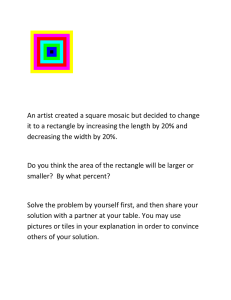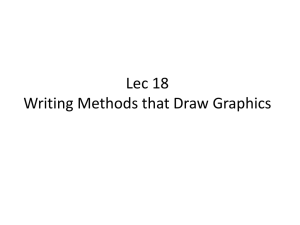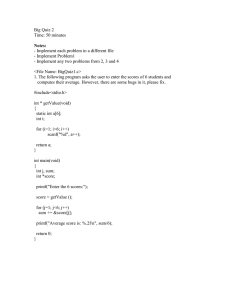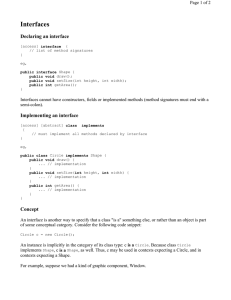1424585632.9724chapter 3
advertisement
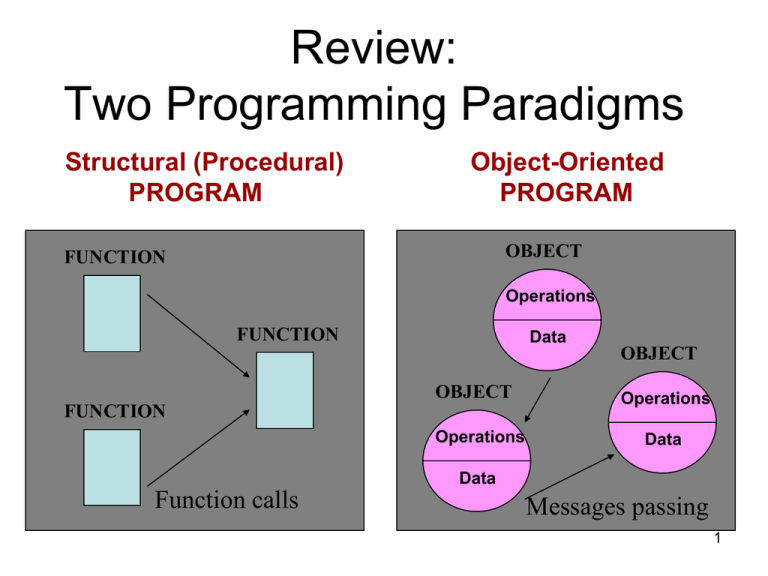
Review:
Two Programming Paradigms
Structural (Procedural)
PROGRAM
Object-Oriented
PROGRAM
OBJECT
FUNCTION
Operations
FUNCTION
Data
OBJECT
OBJECT
FUNCTION
Operations
Operations
Data
Data
Function calls
Messages passing
1
Review: Object-Oriented
Programming Language Features
1. Data abstraction
2. Inheritance of properties
3. Dynamic binding of operations to objects
2
Review: C++ Data Types
simple
integral
enum
structured
floating
array struct union class
char short int long bool
float double long double address
pointer
reference
3
Object-Oriented Programming-Introduction to Classes
• Class Definition
• Class Examples
• Objects
4
Classes & Objects
• The class is the cornerstone of C++
– It gives the C++ its identity from C
– It makes possible encapsulation, data hiding and
inheritance
• Class:
– Consists of both data and methods
– Defines properties and behavior of a set of entities
• Object:
– An instance of a class
– A variable identified by a unique name
5
Classes & Objects
Rectangle r1;
Rectangle r2;
Rectangle r3;
……
class Rectangle
{
private:
int width;
int length;
public:
void set(int w, int l);
int area();
};
int a;
6
Define a Class Type
Header
class class_name
{
permission_label:
member;
Body
permission_label:
member;
...
};
class Rectangle
{
private:
int width;
int length;
public:
void set(int w, int l);
int area();
};
7
Class Definition-Data Members
• Abstract the common attributes of a group of
entities, their values determine the state of an
object
• Can be of any type, built-in or user-defined
• non-static data member
– Each class object has its own copy
– Cannot be initialized explicitly in the class body
– Can be initialized with member function, or class
constructor
• static data member
– Acts as a global object, part of a class, not part of an
object of that class
– One copy per class type, not one copy per object
– Can be initialized explicitly in the class body
8
Static Data Member
class Rectangle
{
private:
int width;
int length;
static int count;
public:
void set(int w, int l);
int area();
};
Rectangle r1;
Rectangle r2;
Rectangle r3;
count
r1
r2
width
length
r3
width
length
width
length
9
Class Definition – Member Functions
• Used to
– access the values of the data members (accessor)
– perform operations on the data members
(implementor)
• Are declared inside the class body, in the same
way as declaring a function
• Their definition can be placed inside the class
body, or outside the class body
• Can access both public and private members of
the class
• Can be referred to using dot or arrow member
access operator
10
Define a Member Function
class Rectangle
{
private:
int width, length;
public:
void set (int w, int l);
int area() {return width*length; }
};
inline
r1.set(5,8);
rp->set(8,10);
class name
member function name
void Rectangle :: set (int w, int l)
{
width = w;
length = l;
scope operator
}
11
Class Definition – Member Functions
• static member function
• const member function
– declaration
• return_type func_name (para_list) const;
– definition
• return_type func_name (para_list) const { … }
• return_type class_name :: func_name (para_list) const { … }
– Makes no modification about the data members (safe
function)
– It is illegal for a const member function to modify a
class data member
12
Const Member Function
class Time
{
private :
int hrs, mins, secs ;
function declaration
public :
void
Write ( ) const ;
function definition
};
void Time :: Write( ) const
{
cout <<hrs << “:” << mins << “:” << secs << endl;
}
13
Class Definition - Access Control
• Information hiding
– To prevent the internal representation from direct
access from outside the class
• Access Specifiers
– public
• may be accessible from anywhere within a program
– private
• may be accessed only by the member functions, and
friends of this class, not open for nonmember functions
– protected
• acts as public for derived classes (virtual)
• behaves as private for the rest of the program
• Difference between classes and structs in
C++
the default access specifier is private in classes
the default access specifier is public in structs
14
Class Definition - Access Control
• The default access specifier is private
• The data members are usually private or protected
• A private member function is a helper, may only be
accessed by another member function of the same
class (exception friend function)
• The public member functions are part of the class
interface
• Each access control section is optional, repeatable,
and sections may occur in any order
15
Objects
Object:
a variable or an instance of a class
Declaration of an Object
Initiation of an Object
16
What is an object?
OBJECT
Operations
Data
set of methods
(public member functions)
internal state
(values of private data members)
17
Declaration of an Object
class Rectangle
{
private:
int width;
int length;
public:
void set(int w, int l);
int area();
};
main()
{
Rectangle r1;
Rectangle r2;
r1.set(5, 8);
cout<<r1.area()<<endl;
r2.set(8,10);
cout<<r2.area()<<endl;
}
18
Another Example
#include <iostream.h>
// member function definitions
class circle
{
private:
double radius;
void circle::store(double r)
{
radius = r;
}
double circle::area(void)
{
return 3.14*radius*radius;
}
void circle::display(void)
{
cout << “r = “ << radius << endl;
}
public:
void store(double);
double area(void);
void display(void);
};
int main(void) {
circle c; // an object of circle class
c.store(5.0);
cout << "The area of circle c is " << c.area() << endl;
c.display();
}
19
Take Home Message
• Class can be considered as a user-defined
data type, while an object is just a variable
of certain class.
• There are three parts in the definition of a
class: data members, member functions,
and access control.
20

